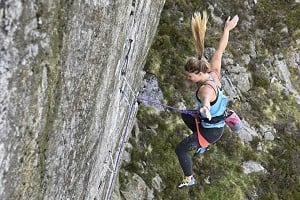
A light-hearted article on Falling by UKC user Steve Chadwick, from several perspectives: The Watcher, The Holder and The Fallen.
There are a group of sports that have 'falling' as a major contributory factor, either by the deliberate act of a jump, or by it being the ultimate penalty of making a mistake. The former can be characterised by offshoots of parachuting, and now include of course 'bungee jumping'. For a climber a fall is the result of failure, and this is of course the nub of our entire sport, in that the risk of pain and injury is always there. The degree to which we overcome our fear coupled with the degree of skill we may, or may not have, largely denotes the grade to which we will climb. Our sport differs from the 'deliberate fall' sports in that at no time does the climber plan to jump as part of the experience. Though sport climbers may argue that falling is a major part of their sport, and no doubt competitors in climbing competitions can push themselves to the limit knowing that they will not fall far.
Whatever game you play, the one thing that is universally accepted is that no one wishes to meet the ground whilst accelerating to, or falling at terminal velocity. The fun is to tempt fate, not to join it, thus overcoming the fear of falling is the biggest challenge facing the climber. More than 99.9% of the time we reach the top without incident, so theoretically we could have soloed the route; but still we climb with a full array of gear, indeed a multi-million dollar industry is based around feeding our continued desire to climb and yet not to die. Why? Because we are afraid of falling, and the survivalist instinct runs deep in all of us. A fear of the dark is a trait in us from birth. A throw back from when we lived in caves and very unpleasant animals roamed about at night. I am not sure if our fear of heights has the same hereditary roots, however the lessons start rolling in from an early age. Idiotic parents encourage their offspring to take early first steps, so they can proudly say "My little Mickey was walking at 11 months" ignoring the fact that after his first faltering steps he fell over, smacked his head on the floor, found out that falling hurts, and didn't walk again for the next three months.
For climbers, the act of falling can be loosely put into three categories: the watcher, the belayer & the fallen.
The Watcher:
The act of watching a fall is not something you can plan, unless you visit climbing competitions & climbing walls. Though if you climb for long enough you are bound to see a few involuntary falls. The first fall I witnessed occurred at Frogatt on 'Three Pebble Slab'. I should say at this point that if you risk falling, try to ensure it is on steep ground. Sliding on slabs is a most painful experience, giving rise to bad lacerations and burns before you even hit the ground. Some of my friends refuse to climb on anything below the grade of VS, their logic running along the lines of "If it's hard it will be steep, and a fall will mean a drop into space and not a smack into the rock". I think of Etive slabs and say nothing. But I digress – the climber on Three Pebble Slab had made the move onto the slab and was teetering on its lower edge, his mind a torment of indecision, unable to reverse the bulge and too scared to go on up the slab. A feeling familiar to many of us at some time of our climbing lives, and if you don't admit it, you're lying.
I ran round to prepare a top rope, but too late, and could only watch as the leader lurched half way up the slab. He reached too high for a pebble that had long since gone, and his feet slid away. The slide & fall over the lower bulge resulted in a broken arm & lacerations. Soon after he gave up climbing and took up sub-aqua diving, and I always wondered if this was as a result of some Freudian impulse whereby his mind decided to move his body to a sport which included safe free fall.
Back to Etive Slabs again. It had been a good day and we had done a few fine routes. I had not fallen, and this despite being on the first pitch of The Long Reach, when I had happened to glance down to find that an attractive lady had taken up residence on the coffin stone and was sun bathing dressed only in a lacy bra & pants. I trembled, but stayed on. Anyway we were bathed in that pathetic self-opinionated glow that you get when you think you have done ok, and thoughts were turning towards a well-earned pint. A lad was high up on the crux of The Pinch, a route I had led earlier in the day. I turned to my mate and uttered those fateful providence-tempting words; "He's on the crux now." Then suddenly he wasn't, if you see what I mean. There was a slithering scrape, a choked cry, and he was off, obeying that law of gravity that we all fear. Back down the way he had come and over the overlap. I still feel guilty to this day, that it was somehow my fault, that as soon as I had uttered those fateful words, he was doomed.
Keith Myhill was a long-standing climbing partner of mine and a Peak District hard man of the late sixties and early seventies. Keith was sitting on Windy ledge Stoney Middleton one day, watching mates on routes above when he realised a climber was having trouble on the 1st pitch of Windover that leads to the ledge. He soloed down until he was alongside the climber and began to talk him up; yes, Keith was that good. A hold came out and Keith tumbled to the ground. A climber ran over to see how he was, and then rushed off to call an ambulance. Meanwhile after the initial shock had worn off Keith checked himself over & found that apart from hurt pride he was uninjured so drove home to Sheffield. On the way he met a flashing ambulance racing in the opposite direction.
The next week Keith was back at Stoney Middleton and was parked beneath White Knight when the leader fell, unzipped a few runners, and crunched onto the bonnet of Keith's car. The car was OK, but the climber was not, so Keith drove down to the nearest house to call an ambulance. He was met at the door by a frosty response and the words "No you can't use the phone, last week someone called for an ambulance and the fallen climber got up and walked off before the ambulance got here!"
The Holder:
I make no claim to be a good climber; my ambition has always been held in check by my ability, or lack of it. I just love the game; it's as simple as that! This has led over the years to a preponderance of me holding the rope for some very good climbers, and I feel privileged to have done it. This has meant that sometimes I've belayed at the bottom of pitches, looking up with a crick in my neck and thinking "grief, if he does this I have to follow it."
In the blinding glory of the leader the art of the faithful second is largely understated. All alone in the world connected by an umbilical cord that winds it's way up to a leader that left sometime ago and that you presume is still up there somewhere. On multi pitch climbs you are often out of visual contact for long periods of time. Like fishing, the line will twitch now and again and you will pay out some rope. Though on occasion this isolation is brought to an abrupt end by a shriek, sometimes precluded by those famous words "I'm off." There is a swish as the rope plays through the runners, strains are equalled out, a strong pull on the second, and the leader hangs swinging out in space sometimes right in front of you.
Theoretically the second, or belayer should be the person least at risk, though debris dislodged by the sharp end hero has a tendency to fall downwards. Helmets of the professional second, especially in winter, are always a deal more damaged than those of the leader.
In their pursuit of leader protection, many a second has taken a calculated risk and broken the rules. It was a warm day at Stoney Middleton, Derbyshire, and a certain well-known climber was a fair way up Gesemini with little protection when he fell. The alert second had done his calculations and was aware that a fall would mean a ground hit for the leader. When the fall came the response was automatic. In order to shorten the fall distance, and to bring in as much rope as possible, the belayer jumped down the slope below the route, bizarre but logical. The ground below Gesemini slopes away steeply so by jumping the second considerably reduced the fall of his leader, who was brought to a halt before he hit the ground. The second however suffered a painful broken finger; such are the injustices of life.
The dynamics of holding a fall are well known; the reality however can be a little savage. In the days before stitch plates, my partner and I were well up the North Face of the Triolet, just a few pitches short of the traverse into the ice chute, when my partner complained of feeling unwell. I strongly offered to continue leading but he wished to do his share. Just above us was a 3m band of very steep ice, so once he was over this he was out of sight. The rope continued to run out, though I sensed hesitancy in the flow. This was early front pointing days and I was using a Pterodactyl and a Chouinard hammer. On long North Face ice routes you tend to go for it, running out entire ropes before belaying. He had run out 25m when there was a cry, an immediate slackening of the rope & tell tale coils came down over the wall; my leader was off! I managed to take in a few metres of rope and braced myself, half a left foot on the small nick I had cut, rope around my waste, belayed to two ice screws.
With no runners he flew down the face, out over the short wall and on down the face at a sickening speed. Belayed to two dubious ice screws, one tube & one corkscrew, there was no way I could risk bringing him to a sudden bouncing halt, the jolt of which would destroy the anchors. The immense tug came and the rope sped out around me as I slowly brought my belaying hand tighter across my body. I had to stop him before the rope ran out, but dared not do it too fast. I was finally pulled from my stance into a horizontal position on the face, hanging from the two ice screws. One immediately pulled out leaving the tube that held but the ice cracked and fractured around it. I continued to slow my partner down until he finally stopped when I had just a small loop of free rope left.
For me the world stood still as I gazed transfixed at the single, gently flexing ice screw that was all there was between us and a date with the mouth of the gaping bergschrund at the base of the mountain far below. I called out and received a groggy response. I suggested somewhat forcefully that if he could establish himself on the face then he should do that very quickly, so as to take the strain off the rope, or we might be continuing on down the face. Once he was established on the face I assessed the situation; the mitt on my right hand was badly burnt, but the really frightening thing was that the outgoing rope around my waste had almost burnt right through the belay rope that was holding me onto the last ice screw. Only a few strands of core and the outer braiding on one side was holding me onto the ice screw. There is no doubt that the dynamic belay had saved us, but the burn caused by the outgoing rope had almost killed us.
The odd thing is that a falling leader can often psyche out the belayer far more than the leader. The scenario for thoughts of a fallen leader goes something like this: "What a pratt, how could I have fallen off there, I'm going straight back up and do it right." For the second it runs a little differently: "Hell, if he has fallen off what chance do I have."
The Fallen
"Behold how the mighty are brought down" don't know who said it, but I remember it from somewhere. To lead is all, but the leader may fall. Therein lies the quixotic heart of climbing, the fear and the fun is all in the risk. How many times have you completed a route and thought to yourself "I reckon I could solo that" or could you? The rope and your equipment gives you control over your mind. The envelope of your desire to 'risk' was manageable, but for most of us mortals serious solo climbing is a step beyond.
Whatever your level of need, you are hooked on the need for a fix. I believe that climbers are still children inside, that have never lost the desire to dare, and are adrenaline junkies. The late great Al Rouse called it the need to "feed the rat."
The fall can be sudden, caused by an unexpected slip or a broken hold, or it can come with a slow inevitability, your fingers uncurling from its strenuous grip, or your jammed fist slowly coming out from the crack. The good belayer learns to look out for the signs. The shaky leg syndrome. The hand scrabbling quickly for a dive into the chalk bag. The hands swapping for a rest just a little too quickly. Verbal clues can be useful.
Leader "Watch me here"
Belayer "I am watching you"
Leader "No, I mean really watch me here"
Belayer to himself "Sh** he's gripped again!"
The shout "I'm off" is a positive indicator.
The classic hero leader as he falls has the presence of mind to shout "BELOW" to warn those below to get out of the way. Though such instances of thoughtfulness in the face of fear are rare.
In the sudden fall category I was once leading Goliath Groove at Stanage. My second was belayed at the half way ledge, when my jam suddenly popped from the top bulge. A runner held & I was brought to a stop face to face with my second. Somewhat embarrassed I fled on up the route before my second could berate me, which he did of course anyway.
The slow slip is worse in that its inevitability brings fear. Towards the top of a damp HVS crack climb at Frogatt edge. My fist jam was in a keyhole slot & as I moved up the jam was sliding out. I tried yo yoing several times trying to reach the finishing jug before the jam popped out. One more time & fingers brushed the jug but could not hold, the jam slid out & my body fell according to Newton's laws of physics, and I descended groundwards. Apparently I let out a scream of some proportion as I fell, finally being held by an original Moac runner and was left dangling away from the rock some metres off the ground. Those that had rushed to the scene on hearing the scream came upon my second holding me & laughing, as I swung unharmed out in space.
Do you ever get the feeling that some falls happen as a punishment? I was acting as a weekend VI (voluntary instructor) for Whitehall outdoor centre in 1970, when I was asked to take two good looking teenage girls to Froggat edge for a days introduction to rock climbing. I wore a black jumper with a go faster stripe and the badge of an Alpine club. I was out to impress and maybe get a date for the evening. All went well and things were looking good for later when Keith Myhill, my erstwhile partner of that period showed up and suggested we do a good climb while the girls had a lunch break.
Keith suggested Valkyrie and I could hardly demur as the two girls looked on doe eyed. Keith led up the crack & round the arête in his usual good style, and belayed. I followed and was summarily ejected from the steep front crack, not once but twice! I was so mad & gutted that I finally beat the crack & almost ran up to the belay then led on up the short wall and mantelshelf to the top. But too late, my street cred had crashed and my licentious plans had crumbled along with my ego. It had to be an act of God, and I bet he was up there behind some cloud laughing his socks off.
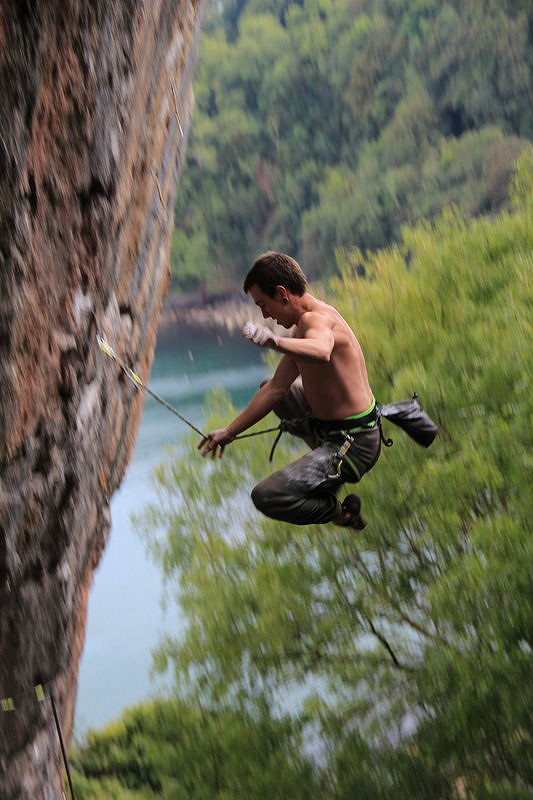
Three decades and a myriad of climbs later, the same desire to climb coupled with less than perfect ability, is still with me. My home for the last sixteen years has been in Gairloch in the northwest Highlands, where I have been involved with many new routes. One of my favourite hills has been Alligin, partly because is greets me from across the loch each morning, and partly because the potential for new winter routes was so huge. It was also the scene of what many of us fear most; my only leader fall in winter
The end of March 1995 and the season was fast coming to a close. Alan Gorman a local climbing friend called, "could I think of anything that might still hold ice?" Poachers Falls and the rest had never really re-formed from to their February pristine nick, but some of the high north side routes of Alligin can hold ice 'till surprisingly late. A very early start was made and we were the first car into Alligin car park. We made steady progress up the Coire Mhic Nobuil path and then up the Bealach a Chomhla on the track below the northeast face of the Horns of Alligin. I was after repeating one of my own routes Diamond Cleft, as it has a superb cleft of ice in its upper section and is high enough to stay intact for long periods. It was not to be, as even this was black with running melt water. We went on round and up to that fabulously lonely place, Toll nam Biast, which lays wild and secluded below the huge north face of Sgurr Mhor. On the right of the face a large buttress rears up, and through it I knew ran an unclimbed steep line of weakness. The groove was still draped in ice but I said nothing and waited to see if Allan would spot it. "Look at that" he enthused, and the cat was out of the bag.
Enthusiasm is a heady thing for it was a great line. We alternated and pitch followed pitch with Allan forcing the main groove as our world closed in to a 5m-visibility cocoon. A storm had blown in and heavy snow swirled, covering the rock, the rope and us; sometimes existence is only as much as you can reach and touch. I started up a snowfield that led to an exit groove through the last rock band. It was steep and runnerless and as I gained the exit snows I was conscious of the long sweep of rope descending down to an invisible belay lost in the swirling snow. All the way up the route had been too steep for the snow to settle, but up here some 5m short of the north ridge the angle lay back and fresh snow had gathered. As I traversed up and right the surface became more unconsolidated. Experience was ringing bells in my head. "Change tools around, put the axe in your right hand and carve a trench through to better snow". But no, I relied on pushing my tools into the mush.
The fall was sudden and shocking in its speed. The unconsolidated snow gave way and I shot off down and over the cliff I had bypassed when climbing the exit groove. I hit the steep snow of the terrace on my backside and bounced off into space once more. Providentially Allan had a good rock belay and after a second or two of falling that seemed like a lifetime I was brought to a swinging halt. I was unhurt as I had shot over the cliff and my arse had absorbed the glancing impact of hitting the steep snowfield. Only one thing to do in situations like this, especially when given a second chance, go up and do it right.
The route was complete and I navigated us through the raging white out down the ridge, across the corrie and on down to the snow covered Coire Mhic Nobuil path. Back down to the car by torchlight, surrounded by the white silence of falling snow, each of us prisoners to the weariness of a long day. Behind us invisible but huge and brooding in the last heavy snow fall of winter lay Alligin. Born on the wind along with the snow that swirled around me came the breath of the mountain 'Take care Stephen, falling can be terminal.'

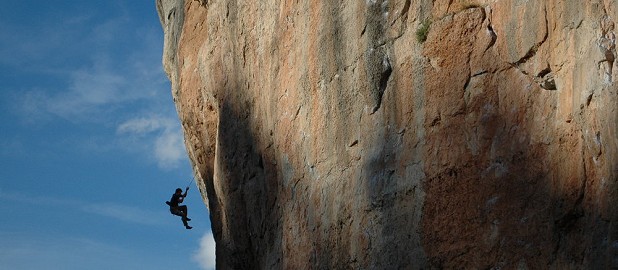
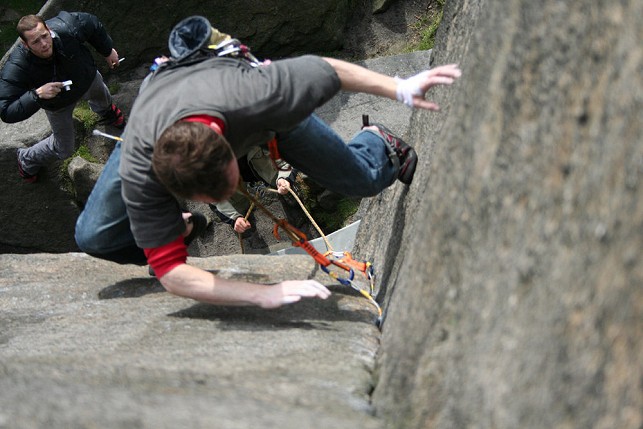
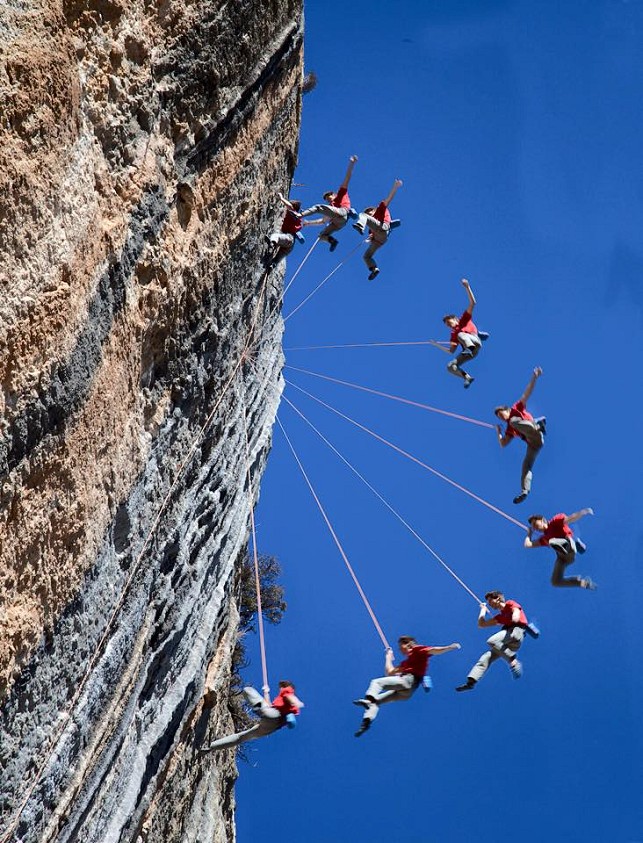
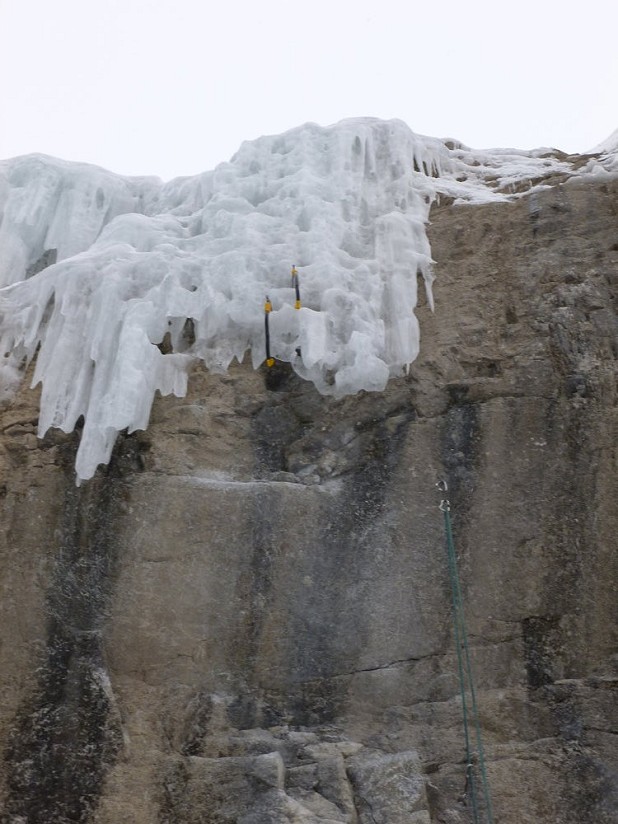
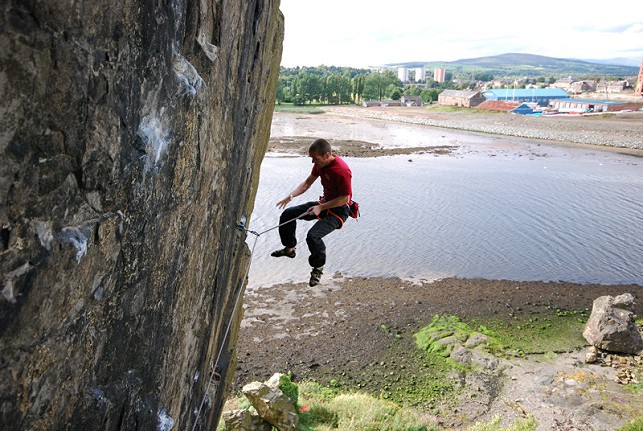
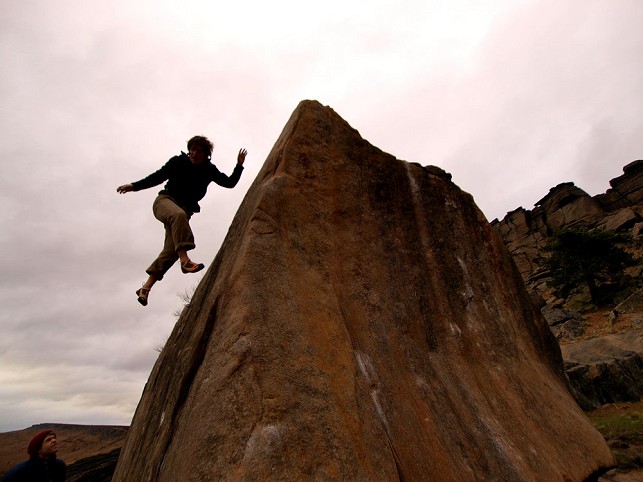
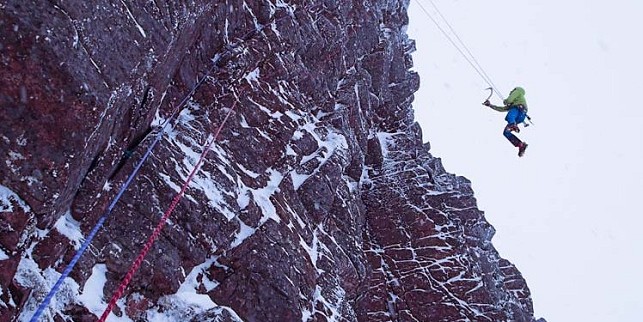
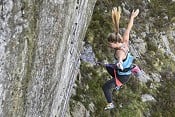
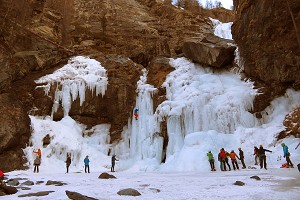
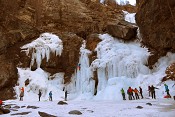
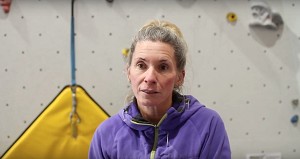









Comments